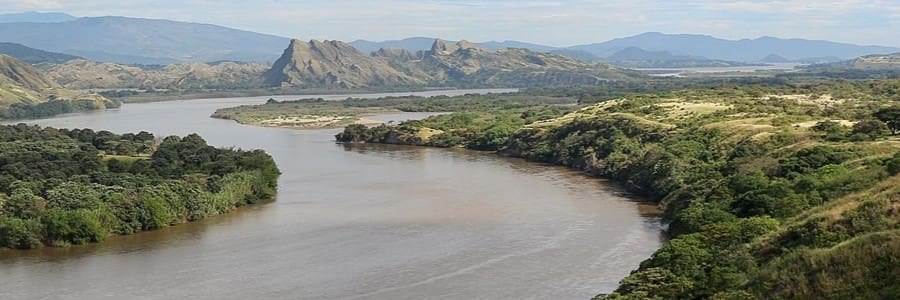
About The Magdalena River
The Magdalena River that flows mysteriously through Colombia takes its name from the Biblical figure – Mary Magdalene.
The largest and most widely navigated river in Colombia, the Magdalena River flows northward through the countryside for almost 1000 winding miles. The Magdalena River Valley is home to almost two thirds of the population of Colombia. It’s waters flow from the heights of the Andes Mountain Range and terminate at the Caribbean Sea near the city of Barranquilla. During the Spanish colonization of the Americas, the Magdalena River was the only transport route between Bogotá and the Caribbean Sea port Cartagena de Indias with links to Europe.
River cruising along the Magdalena River of Colombia is new and exciting – this brings an amazing new destination to river cruise enthusiasts where they can visit Colombia and it’s wonderful cities like Cartegena, Bogota, Barranquilla, and Medellin, among others. Visiting these areas brings to life the unique intersection of the ancient cultures and civilizations that lived in the area for thousands of years – and the European Colonial influence still felt from the Spanish Conquistador era.
There is only one river cruise line that calls the Magdalena River home and that is AmaWaterways. The two brand new ships of AmaWaterways now sail the mysterious waters of the Magdalena on a magical and awe-inspiring journey through time. These river cruises are the perfect way to meld interest in cultural history and fascination with amazing species of wildlife that call the Magdalena River home.
Magdalena River Stats
Length: 949 miles
Depth: Between 20 and 60 feet or more
Source: La Magdalena Lagoon, Colombia
Mouth: The Caribbean Sea near Barranquilla, Colombia
Locks: 0
Countries: Colombia
Learn More About the Magdalena River of South America
The Magdalena River, often referred to as “Rio Magdalena” in Spanish, is one of Colombia’s most iconic and vital waterways. Stretching over 1,500 kilometers (about 932 miles) from its source in the Andes Mountains to its mouth on the Caribbean coast, this majestic river plays a pivotal role in Colombia’s geography, history, culture, and environment. Its significance extends far beyond its physical presence, as it has been a source of life and inspiration for countless Colombians throughout the ages.
Geography and Topography
The Magdalena River has its origins high in the Colombian Andes, specifically in the Páramo of La Rusia, located in the Department of Huila. From this point, it winds its way northward through the heart of Colombia, flowing through several major cities and regions, including Neiva, Girardot, Honda, Bogotá, La Dorada, and Barrancabermeja. The river’s journey culminates at the coastal city of Barranquilla, where it empties into the Caribbean Sea. The river’s topography is incredibly diverse, with its upper reaches characterized by steep, mountainous terrain, and its lower reaches featuring wide floodplains and marshy areas. This diversity contributes to its importance both in terms of natural ecosystems and human activities.
Ecological Significance
The Magdalena River basin is renowned for its exceptional biodiversity. It is home to a rich variety of flora and fauna, including numerous endemic and endangered species. The river and its surrounding wetlands provide essential habitats for various bird species, reptiles, and fish, making it a critical area for conservation efforts. One of the most iconic species associated with the Magdalena River is the Amazon river dolphin, also known as the pink dolphin or “bufeo.” These unique creatures inhabit the river’s waters and are a symbol of its ecological importance. Protecting the river and its ecosystems is not only crucial for preserving biodiversity but also for maintaining the livelihoods of communities that depend on its resources.
Historical Significance
The Magdalena River has played a pivotal role in Colombia’s history, serving as a natural trade route and transportation corridor for centuries. Before the advent of modern roads and railways, the river was the primary means of moving goods and people through the country’s interior. Cities and towns along its banks flourished as commercial and cultural centers, contributing to Colombia’s growth and development. During the 19th century, the Magdalena River was a key artery for the country’s economy, connecting the interior with the Caribbean coast. Steamboats navigated its waters, transporting goods like coffee, cacao, and textiles to international markets. The river facilitated Colombia’s integration into the global economy and played a role in shaping its cultural and economic identity.
Challenges and Conservation
Despite its vital importance, the Magdalena River faces numerous challenges today. Pollution from agricultural runoff, mining activities, and urban centers poses a significant threat to water quality. Sedimentation and erosion are ongoing issues, impacting the river’s navigability and the stability of its banks. Additionally, deforestation in the river’s watershed contributes to soil erosion and exacerbates these problems. Efforts to address these challenges include water quality monitoring, reforestation initiatives, and measures to reduce soil erosion. Conservation organizations and government agencies are working together to protect and restore the river’s ecosystems, recognizing its critical role in Colombia’s natural heritage.
Cultural Significance
The Magdalena River holds a special place in the hearts of Colombians, serving as a source of inspiration for art, literature, music, and folklore. Countless songs and poems have been composed in its honor, celebrating its beauty and significance. The river’s cultural importance is deeply intertwined with Colombia’s national identity, and it continues to be a symbol of unity and pride. The Magdalena River also plays a central role in the country’s religious traditions. For example, the annual El Señor de los Milagros pilgrimage in Girardot attracts thousands of devotees who make a pilgrimage along the river to honor a sacred image of Jesus Christ.
Modern Significance
In contemporary Colombia, the Magdalena River remains a vital transportation corridor. Efforts to improve navigability and infrastructure are ongoing, with plans to modernize the river’s transportation network to enhance trade and reduce congestion on Colombia’s roads. Furthermore, the river is a source of hydropower, with several hydroelectric dams situated along its course, contributing to Colombia’s energy production.
